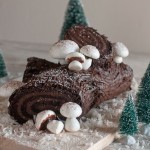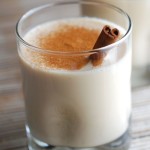There are many different ways people celebrate Christmas. Below are just a small sample of the variety of traditions:
From: Santas.net

Christmas in Germany
Christmas preparations often begin on the eve of December 6th. People often set aside special evenings for baking spiced cakes and cookies, and making gifts and decorations. Little dolls of fruit are traditional Christmas toys.
Children leave letters on their windowsills for Christkind, a winged figure dressed in white robes and a golden crown who distributes gifts. Sometimes the letters are decorated with glue and sprinkled with sugar to make them sparkle.
Germans make beautiful gingerbread houses and cookies. The German Christmas tree pastry, Christbaumgeback, is a white dough that can be molded into shapes and baked for tree decorations.
In parts of Germany, people believe that the Christ Child sends a messenger in Christmas Eve. He appears as an angel in a white robe and crown, bearing gifts. The angel is called Christkind. There is also a Christmas Eve figure called Weihnachtsmann or Christmas Man, he looks like Santa Claus and also brings gifts.
Some homes in Germany have several Christmas trees, and in all towns across Germany, they can be seen glittering and glowing.
In Germany they hang up advent wreaths of Holly with four red candles in the center. They light one candle each Sunday and last on Christmas Eve. Children count the days until Christmas using an Advent calendar. They open one window each day and find a Christmas picture inside.
In Germany the traditional visitor is the Christkindl who is the Christ Child’s messenger. She is a beautiful fair-haired girl with a shining crown of candles who visits each house with a basket of presents.
In some homes a room is locked up before Christmas. On Christmas Eve the children go to bed but are woken up at midnight by their parents and taken down to the locked room. The door is opened and they see the tree all lit up, with piles of parcels on little tables.
In Germany boys dress up as kings and carry a star round the village, singing carols.

Christmas in Italy
The Christmas season in Italy goes for three weeks, starting 8 days before Christmas known as the Novena. During this period, children go from house to house reciting Christmas poems and singing.
In some parts shepherds bring musical instruments into the villages, play and sing Christmas songs.
In the week before Christmas children go from house to house dressed as shepherds, playing pipes, singing and reciting Christmas poems. They are given money to buy presents.
A strict feast is observed for 24 hours before Christmas Eve, and is followed by a celebration meal, in which a light Milanese cake called panettone features as well as chocolate.
Presents and empty boxes, are drawn from the Urn of Fate – lucky dip, which always contains one gift per person. By twilight, candles are lighted around the family crib known as the Presepio, prayers are said, and children recite poems.
At noon on Christmas Day the pope gives his blessing to crowds gathered in the huge Vatican square.
In Italy the children wait until Epiphany, January 6, for their presents. According to tradition, the presents are delivered by a kind ugly witch called Befana on a broomstick. It was said that she was told by the three kings that the baby Jesus was born, she was busy and delayed visiting the baby.
She missed the Star lost her way and has been flying around ever since, leaving presents at every house with children in case he is there. She slides down chimneys, and fills stockings and shoes with good things for good children and it is said leaves coal for children who are not so good.

Christmas in Japan
Only 1 per cent of Japanese people believe in Christ. Even so, most Japanese people decorate their stores and homes with evergreens during Christmas.
They enjoy giving each other gifts, and this is the part they celebrate.
They have a Buddhist monk called Hotei-osho who acts like Santa Claus. He brings presents to each house and leaves them for the children. Some think he has eyes in the back of his head, so children try to behave like he is nearby.
Among the Christian Japanese Christmas is not a day for the family. They do not have turkey or plum pudding, rather than that the day is spent doing nice things for others especially those who are sick in hospitals.
Christmas for those in Sunday schools is the happiest day of the year. On Christmas Eve or Christmas night, the children put on programs that last for hours, they sing, they recite and they put on a drama of the day Jesus was born in Bethlehem.
Most children may not like Hotei-osho so they may receive their presents from Santa who goes around with a red-nosed reindeer.

Christmas in Mexico
Mexicans share many traditions with the Spanish. Their main Christmas celebration is called La Posada, which is a religious procession that reenacts the search for shelter by Joseph and Mary before the birth of Jesus. During the procession, the celebrants go from house to house carrying the images of Mary and Joseph looking for shelter.
Santa Claus is not predominant, but the bright red suit is represented in the traditional flower of the season. This flower is the poinsettia, which has a brilliant red star-shaped bloom. It is believed that a young boy walking to the church to see the nativity scene showing the birth of Jesus had realized on the way that he had no gift to offer the Christ child so he gathered up some plain green branches as he walked in he was laughed at but upon placing the branches near the manger they started to bloom a bright red poinsettia flower on each branch.
The Mexican children receive gifts. On Christmas day they are blindfolded and taken to try and break a decorated clay piñata that dangles and swings at the end of a rope. Once the piñata has been broken, the children clamber to recover the candy that was inside the piñata. Those children who have been good also on January 6th receive a gift from the Three Wise Men.
Mexicans attend a midnight mass service which is called la Misa Del Gallo or “the rooster’s mass,” and at the mass they sing lullabies to Jesus.

Christmas in France
On Christmas Eve, children leave their shoes by the fireplace to be filled with gifts from Pere Noel. In the morning they also find that sweets, fruit, nuts and small toys have been hung on the tree.
In cathedral squares, the story of Christ’s birth is re-enacted by both players and puppets.
Nearly every French home at Christmastime displays a Nativity scene or crèche, which serves as the focus for the Christmas celebration. The crèche is often peopled with little clay figures called santons or “little saints.” In addition to the usual Holy Family, shepherds, and Magi, the craftsmen also produce figures in the form of local dignitaries and characters. The craftsmanship involved in creating the gaily colored santons is quite astounding and the molds have been passed from generation to generation since the seventeenth century. Throughout December the figures are sold at annual Christmas fairs in Marseille and Aix.
The Christmas tree has never been particularly popular in France, and though the use of the Yule log has faded, the French make a traditional Yule log-shaped cake called the buche de Nol, which means “Christmas Log.” The cake, among other food in great abundance is served at the grand feast of the season, which is called le reveillon. Le reveillon is a very late supper held after midnight mass on Christmas Eve. The menu for the meal varies according to regional culinary tradition. In Alsace, goose is the main course, in Burgundy it is turkey with chestnuts, and the Parisians feast upon oysters and pat de foie gras. Le Revellion may consist of poultry, ham, salads, cake, fruit and wine.
In Southern France, a log is burned in people’s homes from Christmas Eve until New Years Day. A long time ago, part of the log was used to make the wedge for the plough as good luck for the coming harvest.
The traditional Christmas is a chocolate log.
In France families once had a Three Kings Cake with a bean hidden in it. Whoever found the bean in their slice was made King, or Queen, for the day.
In France the children go out to look for the Kings, taking gifts of hay for the camels.
Another name for this day is Twelfth Day. It is the last of the Twelve Days of Christmas, which used to be one long holiday. It was the last night of the Feast of Fools before the Lord of Misrule had to give up his crown and become themselves once again.
In France it is a time for the whole family to come together at Christmas time to holiday and worship. On the eve of Christmas beautifully lit churches and cathedrals, ring out Christmas carols with the church bells.
Once dinner is over and the family has retired to bed, they leave a fire burning and food and drink on the table in case the Virgin Mary calls in. Children leave their shoes or wooden clogs called sabots in the hearth for the Christ Child or Pere Noel to fill. In the north of France, children are given gifts on December 6, which is St. Nicholas’ Day, instead of Christmas Day. The adults give each others presents on New Year’s Day.
French children set out their shoes in hopes that le petit Jesus will fill them during the night with small gifts.








